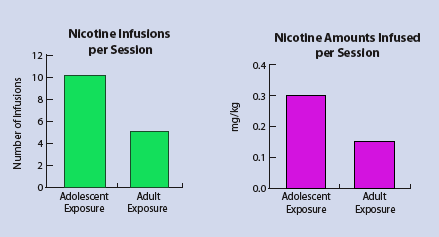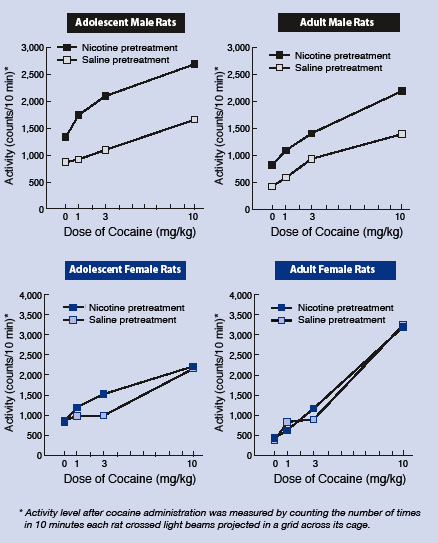 |

By Patrick Zickler, NIDA NOTES Staff Writer
Most tobacco use begins during adolescence, and people who start in their teens are more likely to become life-long smokers than are those who first light up as adults. Adolescent smokers are more likely than adult smokers to become dependent on nicotine. And when compared with nonsmoking peers, young smokers are more likely to be abusers of other drugs: In 2002, the National Survey on Drug Use and Health reported that roughly half (48.1 percent) of youths aged 12 to 17 who smoked cigarettes in the past month also used an illicit drug, whereas only 6.2 percent of nonsmoking youths reported using an illicit drug in the past month.
Rats Exposed to Nicotine in Adolescence
Self-Administer More Nicotine Than Rats First
Exposed as Adults |
 Female rats first exposed to nicotine as adolescents self-administered nicotine more often and in higher total doses per session than rats first exposed as adults. |
|
These observations suggest that teen smokers are especially vulnerable to the physiological effects of nicotine. Two recent NIDA-supported animal studies lend support to this interpretation of the epidemiological data. The results indicate that smoking may be more addictive if it is initiated during adolescence and that early exposure to nicotine may heighten response to other addictive drugs. An additional finding was that males and females may differ in their susceptibility to these effects.
Early Initiation to Nicotine
Dr. Edward Levin and colleagues at Duke University in Durham, North Carolina, investigated whether the developmental period during which rats are first exposed to nicotine makes a difference in their subsequent drive to obtain the drug. One experiment looked at short-term effects, the other at long-term effects.
In the first experiment, the researchers showed that adolescent initiation to nicotine produced a greater intensity of nicotine taking in the days immediately following exposure than was seen in rats initiated to nicotine in adulthood. The researchers trained eight female adolescent rats and seven female adult rats to press a lever to obtain an intravenous injection of nicotine. Following this 2-week training, the researchers gave the rats, now 54 to 62 days old (adolescents) and 84 to 90 days old (adults), free access to the lever daily for 1 hour. The nicotine dosage delivered with each lever push changed each day, in different order for each rat, but over the 8 days of the study every animal had one day each with dosages of 0.01, 0.02, 0.03, 0.04, 0.05, 0.06, 0.07, or 0.08 mg/kg of its body weight. Regardless of dose, the adolescent animals administered more injections each day (average 10.4) than the adults (average 7.5).
Dr. Levin and colleagues next demonstrated that this greater propensity of adolescent-initiated female rats to self-administer nicotine persists into their adulthood. The researchers trained 13 adolescent and 7 adult rats to self-administer nicotine, then tracked their nicotine self-administration for 4 weeks, during which time the adolescents matured into adulthood. Throughout this period, the rats exposed as adolescents pressed the lever for nicotine (at a dose of 0.03 mg/kg) more often than the rats initially exposed as adults (10.1 times per session versus 5.1 times per session).
"At the end of this 4-week period, the adolescent-onset rats were at least 82 days old and were themselves adult," says Dr. Levin. "This finding suggests that those who begin smoking during adolescence are at greater risk for increased smoking over the long term."
These findings are likely to be meaningful for humans as well as lab animals, Dr. Levin observes, since human brains as well as rat brains continue to develop during adolescence. "Self-administration of nicotine during teenage years, when the brain is still developing, may cause some of the developmental processes to proceed inappropriately, in effect sculpting the brains of these adolescents in ways that facilitate the addiction process."
Animal self-administration studies have become a standard tool in nicotine research, but investigation into a possible link between adolescent exposure and severity of addiction has been limited and most work has involved male animals, Dr. Levin points out. In humans, there are notable differences between adult men and women smokers. Men tend to be heavier smokers than women, for example, and women report more severe withdrawal symptoms than men. It is possible that sex differences also occur in adolescent smoking, Dr. Levin observes. "An animal study that uses female rats will more closely model adolescent-onset smoking in teenage girls, a group that is showing a rise in smoking rates," he says.
"Epidemiological data show that adolescent girls exhibit signs of nicotine dependence sooner than adolescent boys. Animal studies show that adult females exhibit greater motivation to self-administer nicotine than do males," points out Dr. Cora Lee Wetherington, NIDA's women and gender research coordinator. "The growing body of evidence on sex differences in response to nicotine emphasizes the importance of including females in animal models of adolescent nicotine use. Dr. Levin's plan to follow up these intriguing findings with a parallel study with males is particularly important," she adds.
Sensitization Differs in Males, Females
Repeated exposure to the same dose of an addictive drug may result in increasingly more intense behavioral response. A dose of cocaine, for example, may elicit more activity on the second day of exposure than did the same dose a day before. This phenomenon, called sensitization, involves drug-induced brain changes that may underlie addiction and can be used to identify differences in susceptibility to the effects of drugs.
Dr. Sari Izenwasser and Dr. Stephanie Collins at the University of Miami found that female adolescent rats show more rapid and pronounced sensitization to behavioral effects of nicotine than adolescent males or adult rats of either sex. In addition, when the researchers administered cocaine to adolescent and adult rats previously exposed to nicotine, adolescent males, but not adolescent females or adults of either sex, exhibited sensitization to some effects of cocaine.
The researchers administered nicotine (0.4 mg/kg of body weight) daily for 7 days to 20 rats, 5 adolescents and 5 adults of each sex. After each injection, the animals were placed in activity monitors—chambers equipped with infrared light beams aimed at detectors on the opposite wall—for 60 minutes while the researchers monitored two aspects of their behavior. Horizontal locomotion was measured by counting the number of times an animal broke light beams. Stereotypy, which involves repetitive actions such as head bobbing, was measured by counting repeated breaks of the same beam. Adolescent females showed increased stereotypy and locomotion in response to nicotine on their second exposure, signifying sensitization, which persisted over the 7 days of repeated administration. Adolescent males, in contrast, showed no locomotor sensitization to nicotine and no stereotypy sensitization until the fourth day of repeated exposures. Adult male and female rats showed sensitization (stereotypy and locomotion) after the fifth day of repeated exposures.
On the eighth day of the study, the researchers investigated the extent to which nicotine exposure affected sensitization to cocaine. They administered cocaine to all the rats in three sequential injections (1, 2, and 7 mg/kg) and monitored the animals' activities for 10 minutes after each injection. For females, previous exposure to nicotine was associated with cocaine sensitization as evidenced by cocaine-induced stereotypy—but not by horizontal movement. Adult males that received nicotine exhibited sensitization to cocaine's effect on horizontal movement but not stereotypy. Adolescent males exposed to nicotine also exhibited greater sensitization than did adult males to cocaine's effect on horizontal movement and were the only group to exhibit sensitization in both stereotypy and horizontal movement.
"Overall, it appears that sensitization to cocaine is more pronounced in adolescent than in adult rats after treatment with nicotine. This suggests that early nicotine use may create an increased risk for young people who subsequently use cocaine, and that adolescent males who smoke may be particularly vulnerable to the risk of cocaine abuse," Dr. Izenwasser says.
"Animal studies such as these are an important addition to a research base that suggests that adolescents show a very different responsiveness to nicotine—upon both acute and chronic or repeated administration— than do adults. The rapid sensitization of adolescent females to nicotine's behavioral effects highlights the need to be aware of gender differences in addictive processes during adolescence," observes Dr. Minda Lynch of NIDA's Division of Neuroscience and Behavioral Research. "Studies such as these also raise important questions about vulnerability to nicotine addiction and on nicotine's potential for cross-sensitization to other drugs of abuse in adulthood or adolescence. And they illustrate the importance of studying drug effects, and the neurological changes they trigger, in the context of the dynamic processes that characterize adolescent brain development."
| Rats First Exposed to Nicotine in Adolescence Show Greater Sensitization to Cocaine Than Rats First Exposed as Adults |
 Rats exposed to nicotine in adolescence and then exposed to cocaine were more sensitive to cocaine's locomotor stimulating effects than rats first exposed to nicotine as adults. Nicotine-induced presensitization to cocaine was greatest in young male rats. |
|
Sources
Collins, S.L., and Izenwasser, S. Chronic nicotine differentially alters cocaine-induced locomotor activity in adolescent vs. adult male and female rats. Neuropharmacology 46(3):349-362, 2004.
[Abstract]
Levin, E.D., et al. Adolescent-onset nicotine self-administration modeled in female rats. Psychopharmacology 169(2):141-149, 2003.
[Abstract]
Volume 19, Number 2 (July 2004)
|
 |
|